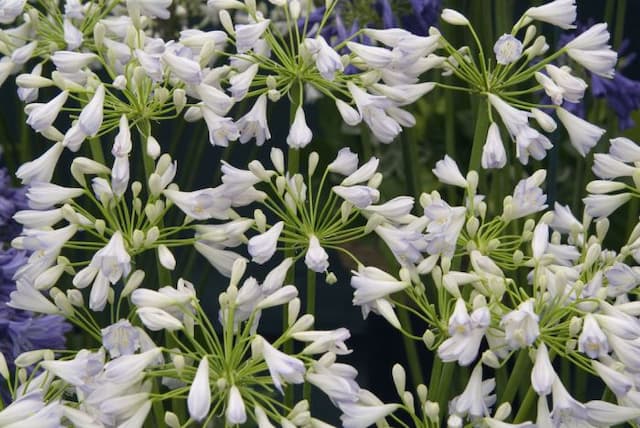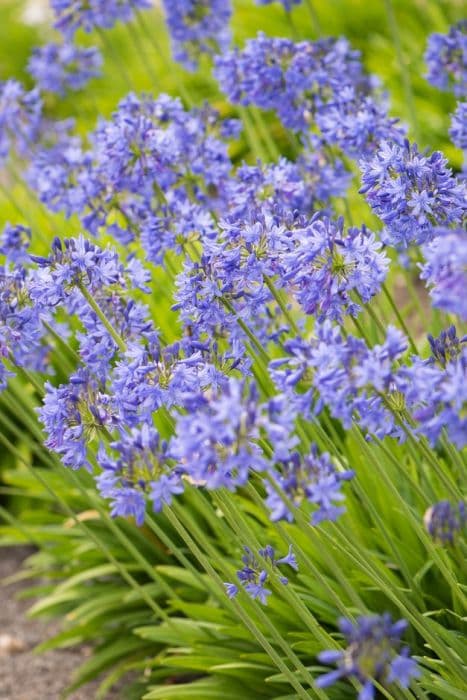African Lily Agapanthus 'Blue Moon'

ABOUT
Agapanthus 'Blue Moon', commonly known as Lily of the Nile or African Lily, is a striking ornamental plant that boasts lush, strap-like foliage. The leaves are a deep green color and create a dense, fountain-like clump from which the flower stems arise. When in bloom, the plant displays rounded clusters of trumpet-shaped flowers perched atop long, sturdy stalks. These flowers are notable for their beautiful soft blue hue, with each individual bloom contributing to the impressive spherical umbels. The name 'Blue Moon' aptly alludes to the light blue to almost silvery coloration of the flowers, which are often admired for their ethereal and cool-toned appearance. The flowers exude a subtle grace and provide a captivating display of cool color in gardens, drawing in various pollinators during their blooming season.
About this plant
 Names
NamesFamily
Amaryllidaceae.
Synonyms
African Lily, Lily of the Nile.
Common names
Agapanthus 'Blue Moon'.
 Toxicity
ToxicityTo humans
Lily of the Nile, despite its beauty, is considered toxic if ingested. All parts of the plant contain compounds that can cause symptoms such as nausea, vomiting, and diarrhea if consumed. In severe cases, more serious reactions like abdominal pain and cardiac arrhythmia may occur, though this is quite rare.
To pets
Lily of the Nile is also toxic to pets. If consumed, animals may experience symptoms such as nausea, vomiting, diarrhea, and possible drooling. Severe cases can lead to tremors or cardiac issues. It is essential to prevent pets from ingesting any part of the plant to avoid these potential complications.
 Characteristics
CharacteristicsLife cycle
Perennials
Foliage type
Evergreen
Color of leaves
Green
Flower color
Blue
Height
3 feet 36 inches (0.91 meters)
Spread
3 feet 36 inches (0.91 meters)
Plant type
Bulb
Hardiness zones
8
Native area
South Africa
Benefits
 General Benefits
General Benefits- Ornamental Value: The Agapanthus 'Blue Moon', commonly known as African Lily, produces attractive blue flowers that enhance the aesthetic appeal of gardens.
- Drought Tolerance: African Lily is known for its ability to withstand periods of low water availability, making it suitable for drought-prone areas.
- Low Maintenance: It requires minimal care once established, making it ideal for gardeners seeking low-maintenance plants.
- Pest Resistance: African Lily is typically resistant to a variety of common garden pests, reducing the need for chemical interventions.
- Attracts Pollinators: The blooms attract bees, butterflies, and other pollinating insects, supporting local ecosystems.
- Long Blooming Period: Its long flowering season provides color and vibrancy in the garden for an extended period.
- Architectural Structure: The plant adds structural interest to garden borders or beds due to its strap-shaped leaves and tall flower stalks.
 Medical Properties
Medical PropertiesThis plant is not used for medical purposes.
 Air-purifying Qualities
Air-purifying QualitiesThis plant is not specifically known for air purifying qualities.
 Other Uses
Other Uses- The thick roots of Agapanthus can be used to stabilize soil and prevent erosion on slopes due to their extensive root system.
- Can be planted in large containers to decorate patios, terraces or balconies, adding an ornamental touch with its lush foliage and tall flower stalks.
- The robust nature of Agapanthus makes it suitable as a living screen or privacy barrier when planted in a dense row.
- They can be used in cut flower arrangements, with their long-lasting blooms providing an elegant feature in floral designs.
- The linear foliage of the Agapanthus can be used as a contrasting texture in mixed perennial borders, playing against the foliage of other plants.
- In coastal regions, Agapanthus is often planted since it is salt-tolerant and can handle the challenging growing conditions near the sea.
- Agapanthus flowers can be dried and used in dried flower arrangements, maintaining their shape and color for long periods.
- Used in theme gardens, such as blue or cool-colored gardens, to reinforce the color scheme with their vivid blue flowers.
- Can be used as a companion plant in rose gardens, providing a complementary color and foliage texture amidst the roses.
- In large public landscapes, Agapanthus serves as a low-maintenance ground cover that requires minimal care once established.
Interesting Facts
 Feng Shui
Feng ShuiThe Lily of the Nile is not used in Feng Shui practice.
 Zodiac Sign Compitability
Zodiac Sign CompitabilityThe Lily of the Nile is not used in astrology practice.
 Plant Symbolism
Plant Symbolism- Love Letters: The name Agapanthus derives from the Greek words 'agape' meaning love, and 'anthos' meaning flower, symbolizing a message of love or an expression of admiration.
- Beauty: The striking blue flowers of the African Lily represent beauty and attention to aesthetics, akin to its own captivating appearance.
- Endurance and Strength: As the African Lily can thrive in harsh conditions and is quite resilient, it often symbolizes the ability to persist and endure hardships.
- Fertility: In some cultures, the abundance of the plant's flowers can be associated with fertility and creation due to its prolific nature.
- Protection: Agapanthus has been thought to ward off evil and is often planted to provide a sense of safety and protection to a place.
- New Beginnings: The plant's lush growth after winter is frequently seen as a sign of new beginnings or starting afresh, reflecting hope and rejuvenation.
 Water
WaterThe Lily of the Nile, or Agapanthus 'Blue Moon', should be watered regularly, ensuring the soil is evenly moist but not waterlogged. During the active growing season in spring and summer, water the plant once a week with about one gallon of water per session, depending on the size of the plant and pot. It's essential to reduce watering in the fall and winter months to prevent root rot. In cooler weather, allow the top inch of soil to dry out before watering again. Always check the soil moisture level before watering to avoid overwatering, as this can lead to fungal diseases.
 Light
LightThe Lily of the Nile thrives best in full sunlight to partial shade. It prefers to be positioned in a spot where it can receive at least six hours of sunlight daily. However, in excessively hot climates, providing some afternoon shade will protect the plant from scorching. Avoid deep shade, as insufficient light can lead to fewer blooms and weak growth.
 Temperature
TemperatureFor the Lily of the Nile, the ideal temperature range lies between 60 to 70 degrees Fahrenheit. It can tolerate a minimum temperature of about 50 degrees Fahrenheit, but growth may slow down. The plant can survive temperatures up to 90 degrees Fahrenheit, but it's important to provide adequate watering and shading in higher temperatures to prevent heat stress.
 Pruning
PruningPruning the Lily of the Nile helps to encourage new growth and improve the plant's overall health. Deadhead spent flowers after blooming to promote additional blooms and remove any damaged or diseased leaves as needed. Cut back foliage in late winter or early spring before new growth begins to keep the plant tidy and rejuvenate it for the upcoming season. Pruning once a year is typically sufficient for maintaining a healthy plant.
 Cleaning
CleaningAs needed
 Soil
SoilAfrican Lily 'Blue Moon' thrives in well-draining, loamy or sandy soil enriched with organic matter. The ideal pH range for this plant is between 6.0 and 8.0. A mixture containing two-parts loam, one-part sand or perlite, and one-part compost or aged manure will provide a nutritious and supportive environment for the optimal growth of African Lily 'Blue Moon'.
 Repotting
RepottingRepot African Lily 'Blue Moon' every 2 to 3 years or when the root system outgrows the current pot. It is best done in spring before the growing season begins. If the plant is not root-bound, repotting can be done less frequently.
 Humidity & Misting
Humidity & MistingAfrican Lily 'Blue Moon' prefers moderate humidity levels but is quite adaptable and can tolerate the humidity levels typically found in most home environments. There is no need for any special humidity considerations as long as the plant is watered properly and not exposed to extremely dry air.
 Suitable locations
Suitable locationsIndoor
Place African Lily 'Blue Moon' in bright, indirect light.
Outdoor
Plant African Lily 'Blue Moon' in full sun to partial shade.
Hardiness zone
8-11 USDA
 Life cycle
Life cycleThe African Lily 'Blue Moon' begins its life as a dormant rhizome or seed, which upon favorable conditions of warmth and moisture, will germinate and sprout. Seedlings first develop a rosette of strap-like leaves, which increase in number as the plant matures. Over time, when the plant is sufficiently mature and conditions are right (usually in its second year), it will send up a central flowering stalk typically in summer, displaying a cluster of blue to violet trumpet-shaped flowers. After blooming, these flowers may develop into capsule-like seed pods if pollination occurs. Post-flowering, the plant redirects energy to its rhizomes, which can expand to create larger clumps or be divided for propagation. Throughout the colder months, growth slows significantly, and in some climates, foliage may die back, with the plant entering a period of dormancy before the cycle begins anew with warmer weather.
 Propogation
PropogationPropogation time
Spring to Early Summer
The most popular method of propagating the Agapanthus 'Blue Moon', commonly known as the African Lily or Lily of the Nile, is through division. This should be done during the spring before the growing season starts, as the plant emerges from dormancy. To propagate through division, carefully lift the plant from the ground and gently separate the clumps into smaller sections. Each section should have at least one or two healthy shoots and a portion of the root system. Replant the divisions immediately, maintaining the same planting depth as before, and water thoroughly to establish the newly transplanted divisions. This method of vegetative propagation is not only efficient for increasing the number of plants but also helps to rejuvenate older clumps that may have become less vigorous over time.









![African lily [Brilliant Blue]](/_next/image?url=https%3A%2F%2Fplants-admin.emdemapps.com%2Fimages%2Fplants%2F%2Fimages%2F604b5e3c28e2b.png&w=640&q=75)